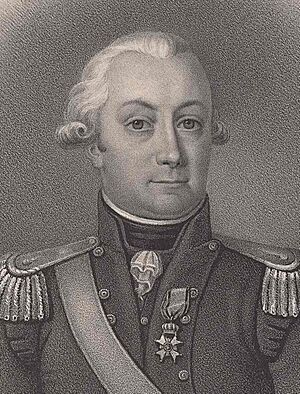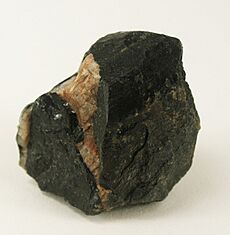Carl Axel Arrhenius facts for kids
Quick facts for kids
Carl Axel Arrhenius
|
|
|---|---|
 |
|
| Born | 29 March 1757 |
| Died | 20 November 1824 (aged 67) |
| Known for | Discovery of mineral ytterbite |
Carl Axel Arrhenius (born March 29, 1757 – died November 20, 1824) was a Swedish military officer, a keen amateur geologist, and a chemist. He is most famous for finding a special mineral called ytterbite in 1787. This mineral was later renamed gadolinite.
Finding ytterbite was a huge step! It helped scientists discover a whole new group of elements that had never been seen before. These are known as the rare earths. Eight stable rare earth elements were eventually found inside ytterbite. They are:
Contents
Carl Axel Arrhenius: Early Life and Career
Carl Axel Arrhenius was born in Stockholm, Sweden, on March 29, 1757. His parents were Jakob Larsson Arrhenius and Brita Sofia Georgii. In 1796, he married Gustafva von Bilang.
Arrhenius joined the Swedish army and became a lieutenant in the Svea Artillery Regiment. This regiment was based in Vaxholm. As an artillery officer, one of his main jobs was to study gunpowder. He did this at the Swedish Royal Mint's laboratory.
Learning about gunpowder from scientists like Bengt Reinhold Geijer and Peter Jacob Hjelm made him very interested in chemistry and mineralogy. This was the start of his scientific studies. It was during this time, in 1787, that he found the special mineral ytterbite.
Meeting a Famous Chemist
In 1787, Arrhenius traveled with Carl Bernhard Wadström and Anders Sparrman to Senegal for scientific research. On his way back in 1787–1788, he stopped in Paris, France. There, he met a very important French chemist named Antoine Lavoisier.
Lavoisier had new ideas about how things burn and how oxygen works. He also did a lot of research on combustion, which included gunpowder. Lavoisier's work helped make gunpowder much better. This was very interesting to Arrhenius because of his military job. Arrhenius became a strong supporter of Lavoisier's new theories in Sweden.
Military Achievements and Later Studies
Arrhenius also fought in the Russo-Swedish War (1788–1790) from 1788 to 1790. He showed great bravery and skill during this war. He was promoted to major in 1801 and later became a Feldzeugmeister, a high-ranking artillery officer. In 1816, he was put in charge of making and checking all the gunpowder for the Swedish army.
Even though he was busy with his military duties, Arrhenius loved chemistry. He became a member of the Royal Swedish Academy of War Sciences in 1799. In 1817, he also joined the Royal Swedish Academy of Sciences. He often wished he had more time for his chemistry studies. When he was over sixty years old, in 1816–1817, Arrhenius even attended chemistry classes taught by the famous chemist Jöns Jacob Berzelius. This shows how much he loved learning about science.
Carl Axel Arrhenius passed away on November 20, 1824.
The Discovery of Ytterbite
While Carl Axel Arrhenius was a lieutenant in Vaxholm, he visited a mine in the village of Ytterby. This village is on an island called Resarön. In 1787, during his visit, he found a dark mineral that was unusually heavy.
The first description of this mineral was published in 1788 by Bengt Reinhold Geijer. He gave credit to Arrhenius for finding this "Schwerstein," which means "heavy rock."
Uncovering New Elements
This "heavy rock" was later sent to a chemist named Johan Gadolin at the University of Åbo for a closer look. In 1794, after carefully studying it, Gadolin announced something amazing. About 38% of the sample was a "new earth" that had never been seen before! At that time, scientists didn't fully understand what a chemical element was.
The compound Gadolin found is now known as Yttrium(III) oxide. It contains the very first rare-earth element ever discovered, which is yttrium.
Another scientist, Anders Gustaf Ekeberg, examined a different sample of the mineral. He confirmed that there was indeed a new "earth" in it. He called this new earth "yttria" and the mineral itself "ytterbite." The mineral that Arrhenius discovered and that Gadolin and Ekeberg studied was eventually renamed gadolinite in 1800. This was done to honor Johan Gadolin's important work.
The Importance of Ytterbite
Rare-earth elements are very similar to each other in their chemical properties. They are almost always found together in minerals on Earth. It's very rare to find them by themselves. Because they are so similar and always found together, it was very hard for scientists to identify them at first.
The discovery of ytterbite was the first step in a long journey of research by many scientists around the world. It took over 100 years to identify all the new "earths." This long process eventually helped scientists understand what elements are and how they fit together in the periodic system.
Ytterbite was eventually found to contain eight stable rare earth elements:
Most of the other rare earth elements were found in a different mineral called cerite. Cerite contains seven rare earth elements:


